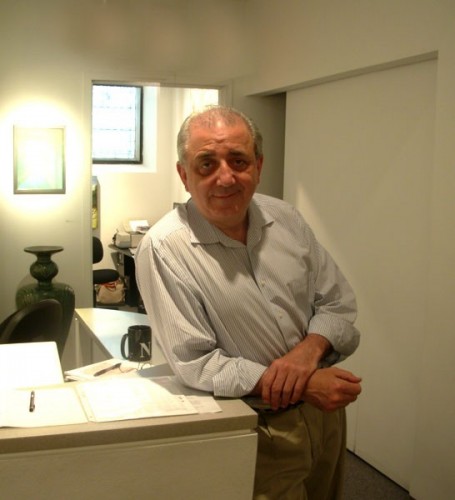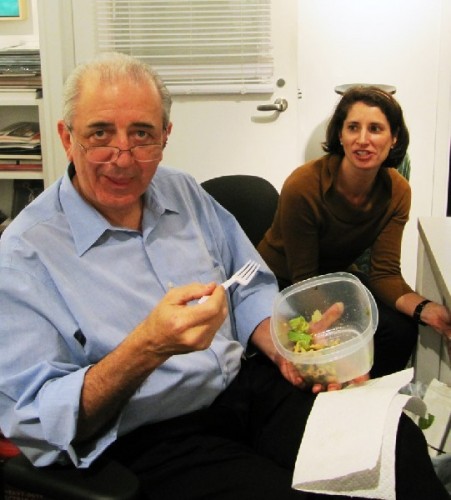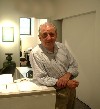Arthur Dion: Beer and Burgers
Boston Gallerist Recalls Decades on Newbury Street
By: Charles Giuliano - Sep 17, 2013
Although witty and urbane to a fault, Harvard educated and all that, Boston gallerist, Arthur Dion, a true man of the people is also a homie. Not to the manor born with a silver spoon in his mouth, as I found out some years ago from the roof deck of our three decker in East Boston. The occasion was a Maverick Arts, then a house gallery, exhibition of East Boston native and member of Dion’s Gallery Naga stable, Robert Ferrandini. During the lively reception for the artist some of us were enjoying the view including a panorama of the Boston Harbor and skyline. Arthur enjoyed pointing out the familiar sites where he had grown up in the surrounding neighborhood.
Roots. He was born in Jamaica Plain in 1946, but lived in Eastie from 1949 to 1952. After Chicopee High School it was on to Harvard, “Which I hated,” from which he graduated in 1968, at the height of a time of student unrest. He was an angry young man on a social mission that included some impoverished time as a teacher.
Not that he has made a fortune in the past 23 years as director of Gallery Naga which focuses on local artists. But he and his wife Diane, who works for WGBH a PBS station, live well in Newton, Mass. and have just seen their son, Nick, through freshman year at the University of Vermont. Currently, the family is building an addition to the house for his mother. Dion projects a sanguine, upbeat demeanor but is guarded about his privacy. Long ago, there was a decision to separate public and private life.
So, over the years, we have met from time to time in bars and restaurants. As we did recently over beer and burgers. We like to pick each other’s brains. And there is no keener observer of the local scene and its complexities. He offers sharp, but often off the record insights of the major institutions and their directors, he has an uncanny close relationship to the MFA’s Malcolm Rogers, to curators, critics and other players. When digging into an arts related news story, Dion has always been a primary source, often with a pithy well worded quote. It has always been useful to bounce something off Arthur to see if I am pursuing the right approach on coverage. Particularly, when I come down hard on a position a wink, nod, shrug from Arthur can be most insightful. It is a role that he appears to enjoy.
While he may reach for the check on occasion sometimes these meetings end up costing me in some way. A couple of years ago, I asked him what was new in the gallery. He was excited about a new artist, Masako Kamia, a couple of days later I bought a piece. As did Dion and his associate, Meg Wilson (White), on the day that Masako first showed them her work. We all wish that we could afford to buy more of her exquisite pointillist paintings.
Which led me to ask what he collects? And whether in the tradition of European dealers he is a risk taker in terms of investing in an inventory of the artists he represents. While the gallery does not engage in the secondary market it will occasionally resell a work acquired through the gallery. And Dion responded that running the gallery was indeed the greatest risk of his life so, “I am risk satisfied. But I do have a Masako painting and a work on paper. But building a suite for my Mom who is 86 is limiting so I don’t expect to be throwing a lot of money at art right now,” he explained. Also their son is in college. But, over the years, he describes a collection of some 200 works. Including a small photo piece by David Prifti “Eye” which he was carrying home that night and insisted on showing to me. “You can tell if the piece was wrapped by an intern based on how much tape is involved,” he quipped as he struggled to reveal the overprotected piece.
Discussing his private collection he explained that it mostly involves artists with whom he has had a relationship. This includes artists who he does not represent. “I have a terrific painting by Gerry Bergstein (with Howard Yezerski)” he explained. “And a great Anna Salmeron photo, a close-up of lips that looks like a landscape. I tend to have things that are emblematic of a relationship. Overall, I have sold just one piece, a great example of work by Ken Beck ‘Cake Pan’ to an important collector of his work. That came at a time when I needed to raise capital for the gallery.”
This led to an overview of the unique approach of Gallery Naga. He described being pulled aside by some established colleagues early on and advised, “You seem like a nice kid, but take some advice. You will never make it selling local artists.” That may have been true at the time but Naga has proved them wrong and now many dealers handle local artists. Naga has been the rising tide that has raised all other ships. Also, Dion is low key and uses the soft sell. For some of his artists, too soft, and they have stormed off. Others would dispute that and state that he is an aggressive and persistent salesman.
“Most people who buy contemporary art are not speculating,” he said. “I actively discourage purchasing art for financial reasons. So there is not a lot of resale with us. Overall, I enjoy studios and working with artists directly and having long term relationships as a home town gallery. When I decided to work for a living I had to pick who to work with. Painters proved to be a good call. I don’t have a dogma about Boston. It is more a matter of who I can work with. In the first ten years at Naga my job was to present the work as well as possible. To try to make it easy to acquire art but I am very reluctant to jump across the counter to interact with people who don’t respect the art or the artists. There is a subset of people for whom collecting is about them. And I’ve never worked well with those individuals. I will work with anyone, high or low, who is enthusiastic about the work and they will get the royal treatment. Not only do Meg and I like and enjoy most of our artists we also like and enjoy most of our clients.”
That raised my eyebrow a bit. Was he fibbing? Glossing over some rough spots? What about Harriet Casdin Silver, now in her 80s, a pioneer of holography and a known diva? “I’m in love with Harriet,” was his explosive and remarkable response. “She is one of the most challenging artists we represent and may be the most important artist I will ever work with.”
After some reflection we discussed Henry Schwartz whom Naga last showed in 1991. He lives in a retirement community and hasn’t worked in years. Arthur visits him and continues to handle his work. “I challenge you to name a more important Boston artist since the departure of Hyman Bloom and Jack Levine and the death of Jack Kramer. Henry was central to the development of the new art scene in the mid 1980s. In a 35 year span of time nobody was more important than Henry Schwartz.” This is an opinion that has been reinforced during recent interviews with artists of the next generation including Gerry Bergstein and Domingo Barreres. Henry was a major presence now much missed. It seems that he never recovered from the post project depression of his retrospective at the Fuller Museum of Art in Brockton.
On the 23 year watch of Dion the Boston art community has grown in strength and diversity. For many of us those years have represented real struggle. But we appear to be at a juncture or turning point. The Institute of Contemporary Art has a $60 million project to build a new home with 60,000 square feet. Or ten times its current space. Similarly, the Museum of Fine Arts is in the midst of an enormous expansion designed by Lord Norman Foster with a pledge to strengthen space and commitment for modern and contemporary art. Given past history there is reason to be skeptical but Dion prefers to be guardedly sanguine. “How can it be anything but good,” he says in response to the ICA plans and regarding the MFA, “Who knows, with more space, it should be good. Perhaps it will be liberating for the MFA to worry less about the mistakes and gaps of the past and to enjoy the present moment.”
Just what is a Naga artist I asked? “Someone who Meg and I find personally important,” he replied. Increasingly she has played a greater role in the day to day life of the gallery. He has been fortunate in having great support staff. Particularly in 1997-1998 when he took a “sabbatical.” Recalling that down time he said, “I was tired. There had been some 15 years that I had devoted to the gallery. I needed some time off and Virginia Anderson took over the day to day operation. I got to spend time in the gym and get my strength back. I continue to work out.”
It is unusual for gallerists to express their angst. Much less to walk off the job for an extended rest cure. There was a lot of buzz at the time and artists who felt they were not getting the professional attention that they required. A couple of them, David Moore and David Palmer, left. Palmer is not represented locally but has flourished on the national and international scene.
With a shrug Dion conveyed that he has often zigged when others zagged. Like his Harvard days. “I was engaged in activity that was antithetical to Harvard’s pedagogical and institutional strength,” he explained. It appears that Harvard did not pay much attention at the time to the needs and interests of undergraduates. That was confirmed by a recent study that rated Harvard students as the most critical of institutions in their peer group.
After some search it would appear that Dion found his niche and an opportunity to lead a fulfilling life. Naga had been founded as an artist cooperative by a group led by Cynthia Howard in 1975. Dion took over in 1982 and later privatized the gallery. By representing exclusively Boston area artists, many painters, with a sub category of studio furniture for which Naga and its partner, Clark Gallery, enjoy a national reputation, Dion proclaims, “We had a stance. The tide has gone in our direction. It would be hard to find a respected person who would not agree that there are fabulous artists in our midst. This is a golden age for Boston artists.”
Reposted from Maverick Arts.



